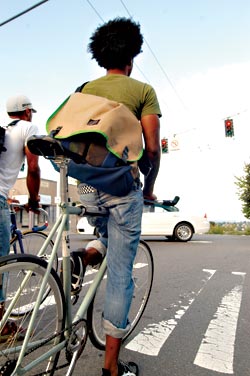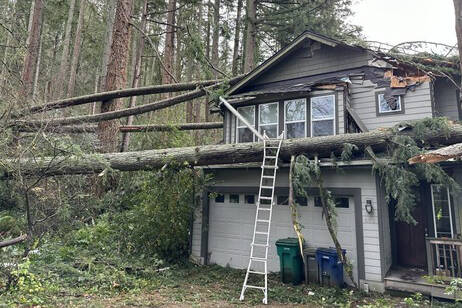Figuring out a route
Sometimes the best way to get to work is not necessarily the shortest or fastest. Most cyclists start out finding the quickest route, or the one best supported by infrastructure such as bike lanes or wide shoulders. After a while, considerations like the pleasantness (or lack thereof) of the route may figure in. Usually the best route is a combination of ease, aesthetics, comfort, and efficiency.
Maps of bike routes throughout King County and the city of Seattle are available through the Cascade Bicycle Club (www.cascade.org) and from Seattle (www.ci.seattle.wa.us/transportation/bikeprogram.htm) and King County (www.metrokc.gov/bike.htm) bicycling program offices. They’re a good place to map out your initial route to work.
Equipment
Here’s what every bike commuter needs:
• Helmet. Wearing one is required both in King County and in Seattle, and for good reason. It is probably the most important piece of equipment you can buy, because it can save your life, and your brain as well.
• Bicycle. You don’t need a fancy bike to commute easily. And everyone has their own taste in what they like to ride: road bike, mountain bike, hybrid, recumbent, single-ring racer, whatever. What really matters is finding a solid, dependable bike that won’t start falling apart after you start putting on the miles.
• Panniers or some kind of gear bag. You’ll need something to carry your work clothes, papers, sack lunches, towels and toiletries for the shower you’ll need at the end of your ride, and whatever else you need for a day at work. Commuter panniers, which are essentially hang-up bags that attach to a bike, can be found in some bike shops.
• Headlights and rear lamps/reflectors. These are essential for anyone riding in any kind of darkness, evening or morning. Like helmets, not only do they save your life, they’re required by law.
• Toe clips and clipless pedals. Optional. These are leg-saving devices that enable you to achieve spin on your pedals instead of just pushing all day.
• Fenders. Strictly optional. These help keep you from getting a stripe up your back and mud in your face when you ride in the rain, but they also cause additional drag on your bike.
• Tools. Not many are needed, but a patch kit, tire levers, some Allen wrenches, and a screwdriver are usually a good idea, unless you’re willing to walk your bike a distance in the event of a breakdown. Spare tubes are usually a good idea, and I like to carry a Swiss Army knife.
• Pump. Essential for refilling your tire in the event of a flat.
• Rain gear. A poncho or raincoat is always a good thing to tuck into your gear.
• Lock. Bicycle thieves are everywhere. Protect yourself with a good U-type lock that can’t be easily cut in the way traditional cable locks can.
A Little Help
Bicycle commuting is always best achieved with cooperation from your employer. Some employers actually provide financial incentives related to “commute trip reduction,” but they are few and far between.
However, you will need two things from your boss:
• A place to park your bike. It’s essential that you have a relatively secure place where you can lock your bike that’s out of the way.
• A shower and locker. Trust me: Your colleagues won’t want to work around you if you smell the way most people do when they’re finished with a nice, sweaty ride.
Of course, it may not be easy convincing your employer to provide these amenities, and they’ll often take as cheap a route as possible. (When I commuted to the old Bellevue Journal-American, I had to shower in the basement pressroom facility.) But if there are other bike commuters among your colleagues, it may help to make a concerted plea. And incentive programs like Metro’s Commuter Trip Reduction can help you make a persuasive case.







